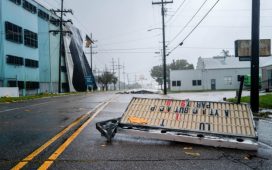Unlock the Editor’s Digest for free
Roula Khalaf, Editor of the FT, selects her favourite stories in this weekly newsletter.
The writer is a fellow at Cornell Tech’s Jacobs Urban Tech Hub
As natural catastrophes such as wildfires and hurricanes have proliferated, insurers have begun to cancel coverage for property owners in vulnerable cities. The root cause of the uptick in weather-induced property damage is, of course, global warming — and to stop tragedy from spreading, we need to move rapidly to alternative energy sources.
While charred homes have become the face of the climate insurance crisis, there is another invisible problem looming: many insurers have been slow to offer coverage for the very types of ambitious clean energy projects that will keep us away from the climate cliff. And that coverage gap risks stymying investment in the energy transition. Without insurance, it’s hard to secure financing to get clean energy projects built.
There are some logical explanations for the industry’s hesitancy. Insurers crunch troves of historical data to assess risk and write policies. Some are still learning how to price coverage for first-generation clean energy sources, such as solar and wind farms. Needless to say, there are few insurance options for the novel technologies that climate entrepreneurs are trying to develop and deploy, such as clean hydrogen power and long-duration energy storage.
In the US, federal spending is currently footing the bill to make clean energy pilot projects happen. But to reach an international scale fast enough, project developers will have to persuade investors that the next generation of climate technologies are safe and reliable — the type of assurances typically offered through insurance policies. Developing these policies will require a rapid evolution of how the insurance industry operates — and a healthy dose of creative thinking.
The modern insurance industry underspends on research and development relative to peer industries, but that was not always the case. During the Industrial Revolution, the sector played a key role in developing the safety standards that enabled electrification. In 1893, a group of underwriter associations hired electrical engineer William Henry Merrill to inspect the wiring at the Chicago World’s Fair. Merrill understood that electrical installations posed a fire risk, but one that could be mitigated with proper design, installation and testing. He opened Underwriters Electrical Bureau, later to become Underwriters Laboratories, a test facility that would certify products as safe. To this day, property and casualty insurers often insist appliances are certified by UL.
Similar collaborations between insurers, standards bodies and entrepreneurs are required for the new electrical age. For example, as commercial electric vehicles like buses and trucks hit the road, insurers will need to increasingly co-ordinate with manufacturers and fire marshals on charging station layouts to reduce fire risk. Some progressive insurers are beginning to leverage artificial intelligence-enabled analytical techniques to predict battery status and health, ensuring safety and reliability.
Much of the engineering talent required to understand risks on new energy products is likely to be found within legacy insurance companies. The risks associated with an offshore wind farm in some ways resemble those of an offshore oil rig. The process for drilling a geothermal well is not all that different from that for fracking for gas. Instead of continuing to underwrite fossil fuels, insurance companies should redirect their expertise towards understanding emerging clean energy technology.
And to move even faster, legacy insurers can explore working with clean energy entrepreneurs to access the data they need. Again, there is a strong history: in the late 1800s, when insurers on America’s east coast wanted to expand west but lacked the regional knowledge to underwrite effectively, they delegated their authority to small “start-up” shops, that were located on the frontier and could see what was happening.
Today, a handful of start-ups — including kWh Analytics, New Energy Risk and Energetic Capital — specialise in aggregating information on energy assets for use in insurance policies. The coupling of real-time data with the predictive powers of machine learning could create a new paradigm for modelling risk.
McKinsey estimates that the insurance market for new energy infrastructure is likely to reach $10bn-$15bn by 2030. Additionally, the auto insurance and home insurance industries — which, together, drive over $1tn of the global economy — will have to adapt to all-electric buildings and vehicles.
These numbers show that insurers that crack the energy transition are likely to reap financial rewards — in addition to being on the right side of history. Rather than underwriting fossil fuels, proactive insurers should seize the clean energy opportunity.









